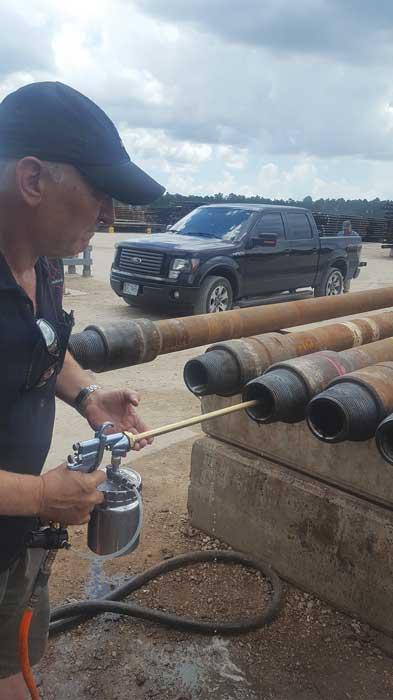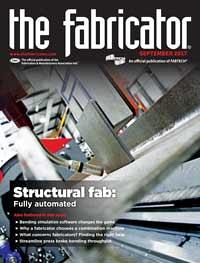Editor-in-Chief
- FMA
- The Fabricator
- FABTECH
- Canadian Metalworking
Categories
- Additive Manufacturing
- Aluminum Welding
- Arc Welding
- Assembly and Joining
- Automation and Robotics
- Bending and Forming
- Consumables
- Cutting and Weld Prep
- Electric Vehicles
- En Español
- Finishing
- Hydroforming
- Laser Cutting
- Laser Welding
- Machining
- Manufacturing Software
- Materials Handling
- Metals/Materials
- Oxyfuel Cutting
- Plasma Cutting
- Power Tools
- Punching and Other Holemaking
- Roll Forming
- Safety
- Sawing
- Shearing
- Shop Management
- Testing and Measuring
- Tube and Pipe Fabrication
- Tube and Pipe Production
- Waterjet Cutting
Industry Directory
Webcasts
Podcasts
FAB 40
Advertise
Subscribe
Account Login
Search
Rethinking the coating and pretreatment relationship
Distributor pulls together two brands that look at part cleanliness and coating development in a different way
Metal fabricators don’t change their processes on a whim. In fact, many don’t have time to even think about major alterations to production processes because the focus is just delivering parts to the customer by deadline dates.
“Every industry faces this. People are focused on what is in front of them. Metal fabricators are focused on fabricating,” said Douglas Foster, a coating specialist at Intuitive Coatings, Driftwood, Texas.
That’s why coatings distributor Rugged Coatings, Camas, Wash., has brought together Intuitive Coatings and CleanWirx, a Houston-based manufacturer of a metal surface cleaner. These companies are approaching surface preparation and coating application in a way that is different from others in the marketplace.
“Any metal fabricator or manufacturer is going to be cautious when it comes to switching technologies because all of what it all entails,” said Rachael Jackson, Rugged Coatings’ director of operations and business development. “I believe with our capabilities with these manufacturers, we tend to be the ones that are developing products and new technologies that are making things happen.”
The Pretreatment Approach
Loren Hatle, one of NACE International’s first certified coatings inspectors (certificate No. 207, to be exact), has more than 35 years of experience in fighting corrosion. In 1991 he launched his new method of metal decontamination that is marketed as CleanWirx today.
“Today we still use technologies to clean the steel based on a visual standard, literally looking at it from 5 feet and without the use of magnification,” Hatle said. “You can have something appear clean, which is very contaminated, and you don’t know it. Unless you are qualified and know what you are doing, it’s hard to even assess those contaminant loads.”
Hatle points to two types of unseen corrosion influencers:
1. Sulfate-reducing bacteria, acid-reducing bacteria, and other microsized contaminants greatly increase the likelihood of osmotic blistering, which captures moisture underneath the coating and leads to corrosion. For example, bacteria settles next to the metal surface and produces acids and other ionic compounds that are difficult to remove using abrasive blasting alone. If these contaminants aren’t removed, they become trapped under the coating, and as moisture begins to permeate the coating film, these particles stimulate the activation of the microbial contaminants and initiate the corrosion process.
2. The presence of soluble salts, which have been discussed in coatings-related literature for nearly 40 years, also contributes to substrate corrosion because of osmotic blistering. A common occurrence that best illustrates this is the creation of ferrous chloride that forms on dry-blasted, chloride-contaminated steel. When steel and chlorides come in contact with the air, the ferrous chloride quickly oxidizes to form ferric chloride, a soluble salt with a natural affinity for available moisture. These residual ferric or even ferrous chloride contaminants on the substrate accumulate moisture from the air, resulting in the formation of a concentrated iron chloride solution on the metal surface. Iron ions, chloride ions, and water comprise an electrolytic solution that drives an electrochemical corrosion reaction that is detrimental to the performance of the coating applied over the contaminated surface.
CleanWirx was developed to eliminate microscropic levels of these contaminants, which obviously goes beyond the accepted visual standard of cleanliness. With the application of a proprietary two-step gel and a patented chemical neutralization agent to decontaminate the metal surface, then followed by a clean water rinse, a coating can be applied, and the fabricator can expect greater resistance to corrosion because of this “uniform receptive site,” according to Hatle. In fact, fabricators involved in oil and gas work can apply CleanWirx right after blasting and eliminate the subsequent steps of dehumidification and reblasting, which normally occur when painting large fabrications that are exposed to the elements in the Gulf Coast region.
“When you start to get that covalent bonding at the substrate and the coating interface, it changes the typical coating equation rapidly,” Hatle said, referring to the use of CleanWirx with Intuitive Coatings’ Ionyx coating product.
The Coating Story
Foster said a lot of the recent work done in developing new coatings has been more about meeting regulatory stipulations rather than pushing performance improvement. Unfortunately, a lot of the components that made coatings very effective in controlling corrosion also happen to be very toxic, and as a result, they aren’t being used anymore.
“What we have done instead of trying to find different compounds to replace other compounds taken out of the coatings is to change what the coating is—its structure or chemical backbone, if you will,” Foster said. “Most coatings—the epoxies, urethanes, and acrylics—are all carbon-based.
They are all basically plastic. Plastics are good for a lot of things, but this issue you have with those plastics is that they eventually break down. It’s organic, and anything that is organic breaks down with age.
“Instead of carbon-based coatings, we made the switch to a ceramic-based or quartz coating,” he added.
With a clean substrate to adhere to, the Ionyx coatings create a covalent bonding with the surface. This is a chemical reaction between the metal substrate and the coating, creating a new surface, not a mechanical bonding process that typically happens when a coating is simply locked onto a metal surface. The coating should not delaminate because the coating and surface have become one.
To achieve this type of covalent bond, typically a coating requires plenty of energy, which might be delivered from a heat source perhaps reaching as high as 350 degrees F. Company officials report that Ionyx coatings obtain this energy by reacting with the water present in the air. This hydrolysis powers the creation of the covalent bond.
In the past such strong coating performance likely would have been associated with the best of the solventborne coatings available to manufacturers. Tighter environmental regulations have forced plenty of coatings manufacturers to rethink the solvents they use to deliver their coatings. Foster said that the Ionyx coatings remain solventborne, but the solvents in use meet even the stringent regulations issued by California’s South Coast Air Quality Management District.
“We use one of two solvents: methyl acetate for California, which is VOC-exempt, and TBA [t-butyl acetate] for the rest of the world,” Foster said.
He added that Ionyx coatings can work right out of the container. No mixing is required. A first pass can deliver a film thickness of about 1 to 2 mils, and that should be about all that is needed for long-term protection of the metal substrate.
“With other coatings, you have to do a first pass and then you have to do two or three more passes to get at the right film build,” he said.
Jackson said that Rugged Coatings has been working with both brands over the last 18 months. She added that with the pretreatment and coating technology having been verified out in the field (see Figure 1), the task is now about getting fabricators to notice that another finishing method may help them in the eternal fight against corrosion.
Rugged Coatings, 866-606-7186, www.ruggedcoatings.com
About the Author

Dan Davis
2135 Point Blvd.
Elgin, IL 60123
815-227-8281
Dan Davis is editor-in-chief of The Fabricator, the industry's most widely circulated metal fabricating magazine, and its sister publications, The Tube & Pipe Journal and The Welder. He has been with the publications since April 2002.
subscribe now

The Fabricator is North America's leading magazine for the metal forming and fabricating industry. The magazine delivers the news, technical articles, and case histories that enable fabricators to do their jobs more efficiently. The Fabricator has served the industry since 1970.
start your free subscription- Stay connected from anywhere

Easily access valuable industry resources now with full access to the digital edition of The Fabricator.

Easily access valuable industry resources now with full access to the digital edition of The Welder.

Easily access valuable industry resources now with full access to the digital edition of The Tube and Pipe Journal.
- Podcasting
- Podcast:
- The Fabricator Podcast
- Published:
- 04/30/2024
- Running Time:
- 53:00
Seth Feldman of Iowa-based Wertzbaugher Services joins The Fabricator Podcast to offer his take as a Gen Zer...
- Industry Events
Pipe and Tube Conference
- May 21 - 22, 2024
- Omaha, NE
World-Class Roll Forming Workshop
- June 5 - 6, 2024
- Louisville, KY
Advanced Laser Application Workshop
- June 25 - 27, 2024
- Novi, MI
Precision Press Brake Certificate Course
- July 31 - August 1, 2024
- Elgin,
































